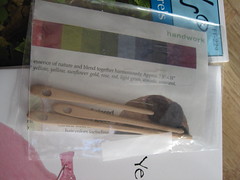Different Types of Embroidery and Cross Stitch Needles
 There are many different types of needles to use in embroidery and cross stitching. Quality and size vary greatly, so try several different needles to find which one you are the most comfortable using. To help you get started, I have written up some basics to keep in mind when choosing which needles to use and when to use them.
There are many different types of needles to use in embroidery and cross stitching. Quality and size vary greatly, so try several different needles to find which one you are the most comfortable using. To help you get started, I have written up some basics to keep in mind when choosing which needles to use and when to use them.
Types of needles:
The most common needle used in cross stitching is an embroidery or tapestry needle. Other needles exist, such as beading, chenille, quilting, and milliners needles, and each type has a specific use. Here is a brief description of each type of needle.
Quality:
Look for high quality needles and threads, as this will make for a more enjoyable stitching experience and produce a higher quality finish. Poor quality needles are harder to thread because they have a rough eye that will actually pull and fray your thread. Poor quality thread will fray easily, making it hard to thread through the needle and giving your finished piece a fuzzy appearance.
Different needle sizes:
On higher count fabric, you need a smaller sized needle. Kind in mind that the larger the number size of the needle is, the smaller the actual needle will be. For example, a size 26 tapestry needle is smaller than a size 24 tapestry needle. The higher the count of the fabric, the smaller the holes in the fabric, therefore you will need a smaller needle. As a guideline, use a size 24 tapestry needle for stitching on an 11 or 14 fabric count; use a size 26 for fabric with a fabric count of 18 or greater.
I hope you have found this information helpful. For more helpful cross stitch tips and tricks, please visit http://www.beautifulcreations.ca and remember to check out our free patterns while you are there.
No comments:
Post a Comment